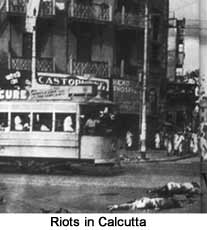

 |  |
 The anticipation of freedom from imperial rule lifted the gloom that had set in with continuous internal wrangling. The statement was enthusiastically received in Congress circles as a final proof of British sincerity to quit. Jinnah was more convinced than ever that he only had to bide his time in order to reach his goal. The anticipation of freedom from imperial rule lifted the gloom that had set in with continuous internal wrangling. The statement was enthusiastically received in Congress circles as a final proof of British sincerity to quit. Jinnah was more convinced than ever that he only had to bide his time in order to reach his goal.This was the situation in which Mountbatten came to India as Viceroy. He was the last Viceroy and charged with the task of winding up the Raj by 30th June 1948. Mountbatten had a clear cut directive from His Majesty's Government, he did not write his own ticket, as he has claimed. He was directed to explore the options of unity and division till October, 1947 after which he was to advice His Majesty's Government on the form transfer of power should take. Jinnah was obdurate that the Muslims would settle nothing less than a sovereign state. Mountbatten found himself unable to move Jinnah from his stand: 'He gave the impression that he was not listening. He was impossible to argue with.. He was , whatever was said, intent on Pakistan.' Mountbatten's formula was to divide India but retain maximum unity. The country would be partitioned but so would Punjab and Bengal, so that the limited Pakistan that emerged would meet both the Congress and League's position to some extent. The Mountbatten Plan, as the 3rd June, 1947 Plan came to be known, sought to effect an early transfer of power on the basis of Dominion Status to two successor states, India and Pakistan. The rationale for the early date for transfer of power, 15th August 1947, was securing Congress agreement to Dominion Status. The speed with which it was done made it worse. The seventy-two day timetable, 3rd June to l5th August 1947, for both transfer of power and division of the country, was to prove disastrous. Senior officials in India like the Punjab Governor, Jenkins, and the Commander-in-Chief, Auchinleck, felt that peaceful division could take a few years at the very least. As it happened, the Partition Council had to divide assets, down to typewriters and printing presses, in a few weeks. There were no transitional institutional structures within which the knotty problems spilling over from division could be tackled. Mountbatten had hoped to be common Governor-General of India and Pakistan and provide the necessary link but this was not to be as Jinnah wanted the position himself. Hence even the joint defence machinery set up failed to last beyond December 1947 by which time Kashmir had already been the scene of a military conflict rather than a political settlement. The Punjab massacres that accompanied Partition were the final reflection of Mountbatten's failure in affecting a peaceful transition. The Boundary Commission Award was ready by 12th August, 1947 but Mountbatten decided to make it public after Independence Day, so that the responsibility would not fall on the British. Independence Day in Punjab and Bengal saw strange scenes. Flags of both India and Pakistan were flown in villages between Lahore and Amritsar as people of both communities believed that they were on the right side of the border. The morrow after freedom was to find them aliens in their own homes, exiled by executive fiat. The end of this section |
Copyright ©2000 indiansaga.info. All rights reserved.
By using this service, you accept that you won't copy or use the data given in this website for any commercial purpose.
The material on indiansaga.info is for informational & educational purpose only.
This site is best viewed at 800 X 600 picture resolution.